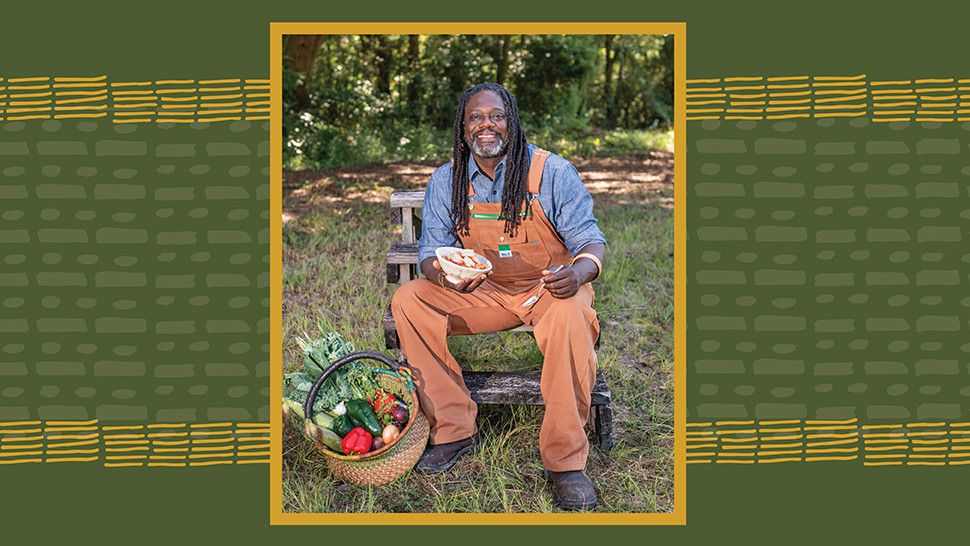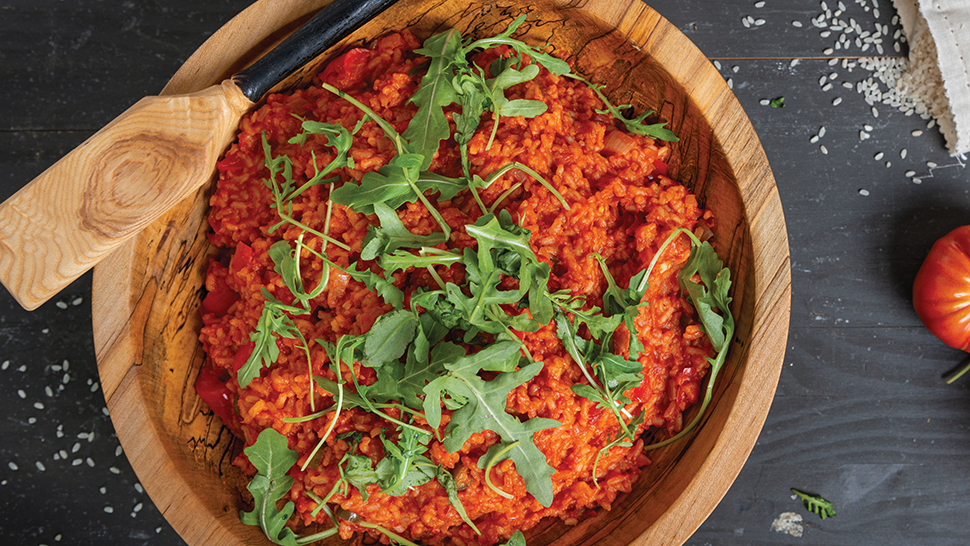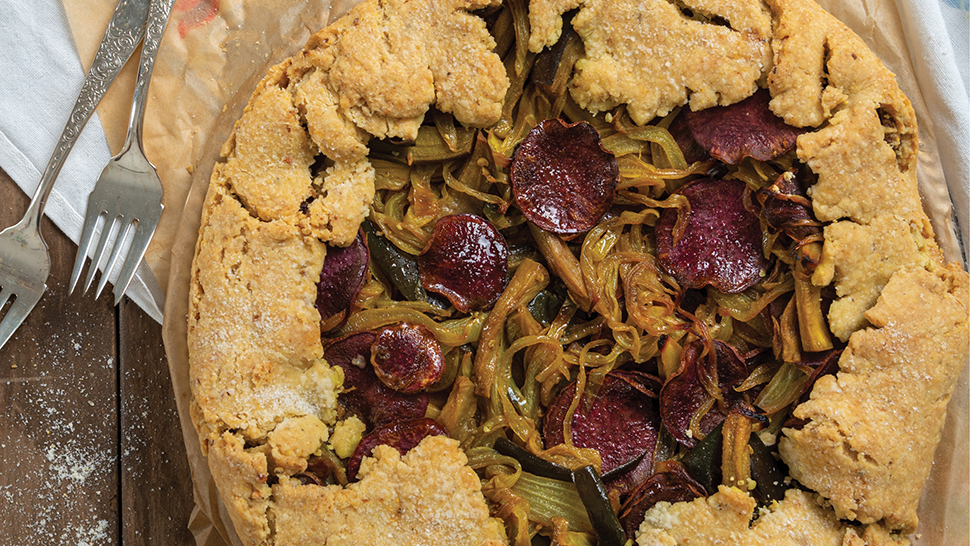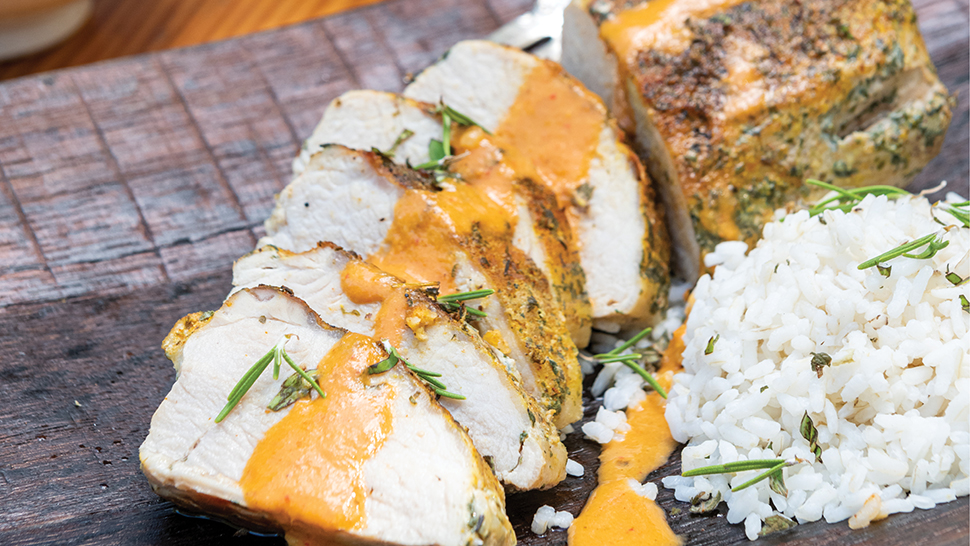
CheFarmer (a combination of chef + farmer) Matthew Raiford recently published his first cookbook, Bress ‘n’ Nyam: Gullah Geechee Recipes from a Sixth-Generation Farmer.
In the book Matthew offers a window into the cuisine and foodways of the Gullah Geechee, the descendants of enslaved Africans who still inhabit their ancestral lands – the coastal lowcountry of the Carolinas, Georgia, and Florida. As a sixth-generation farmer stewarding his family’s land, Matthew pays homage to the food that nurtured generations of his family.
Bon Appétit is thrilled to be partnering with Matthew during this year’s Black History Month celebration, and we encourage you to explore the recipes below, shared by Matthew directly from his book.

Gullah Rice With From-Scratch Vegetable Stock
This one-pot dish is akin to a purloo or a jambalaya. It evokes the traditional tomato-based Savannah Red Rice but is steeped in a hearty vegetable stock. When I was coming up, a bowl of rice with some roasted vegetables in it was often dinner, especially when meat proved scarce. I still find it comforting, just as I did during those lean years when I was at Howard University, right after getting out of the Army. Anytime someone would say they didn’t have any food in the house, I would invite folk over and serve my version of Gullah Rice, finished with a handful of fresh arugula that wilts lightly from the heat.
Serves 4
1 cup red onion, roughly chopped
4 tablespoons bacon grease or butter
1 bell pepper, roughly chopped
2 cloves garlic, smashed and roughly chopped
1 teaspoon smoked paprika
1 teaspoon pink Himalayan salt
1 whole habanero pepper
One 28-ounce can crushed tomatoes
1 3/4 cups Vegetable Stock (recipe follows)
1 cup Carolina Gold Rice or another long-grain rice
In a deep skillet or Dutch oven over medium-high heat, sauté the onion in the bacon grease until it starts to soften, approximately 3 to 4 minutes, then add the bell pepper and sauté for another minute or two more.
Toss in the garlic, paprika, salt, and habanero pepper. Pour in the crushed tomatoes and vegetable stock, then let the vegetable mixture come to boil.
Stir in the rice and turn the heat down to a simmer and cover. Every 5 minutes or so over a 20-minute period, stir the rice until all the liquid is absorbed. Remove the rice from the heat, taste and add a pinch or two more of salt to your liking. Allow the rice to rest for 5 minutes before serving.
Tip: If you want to add meat, sauté sliced smoked or andouille sausage, or chicken tenders cut into chunks, for 5 to 7 minutes before adding the onion. For shrimp, add peeled and deveined shrimp during the last 5 minutes of cooking.
Vegetable Stock
Makes 6 to 8 cups
2 quarts water
1 pound yellow onions, roughly chopped (do not use sweet onions)
1/2 pound baby bella mushrooms, roughly chopped
1/2 pound carrots, roughly chopped
2 stalks celery, roughly chopped
1 tablespoon sea salt
1 sprig rosemary
1 sprig thyme
1 sprig oregano
2 cloves garlic, smashed
Place all the ingredients in a large stockpot over high heat and bring to a roaring boil. Turn the heat to low and let the stock simmer for 1 hour.
Remove the stock from the heat and let it cool to room temperature. Once cooled, strain the stock into 2-cup portions in sealable containers and place in the refrigerator, where it will keep up to 2 weeks. In the freezer, the stock will keep up to 6 months.
Tip: Make a double or triple batch of this stock to keep on hand for rice dishes, soups, and sautés. You can freeze it or keep it refrigerated for up to two weeks. You may add clippings from other vegetables, such as asparagus and other greens, for added flavor, depth, and nutrients. Throw any of your leftover vegetable peels into your compost bin.

Curried Vegetable Galette
Vegetables were the stars on our tables, and they still are. Meat wasn’t always readily available, but because farming families in the Brookman Community shared their harvests and we traded among ourselves, everyone had plenty to eat. We never knew hunger because of that collective spirit. I’ve always been drawn to rustic presentations, things made simply with caring hands, and a modest, unassuming galette represents that warmth and kindness to me. Serve alongside the Watermelon Steak Salad with Heirloom Tomatoes and Sangria Vinaigrette for a balance of savory and sweet sensations.
Serves 4 to 6
For the galette dough
2 cups all- purpose flour
1/2 cup finely ground white cornmeal
1 teaspoon Spike herb seasoning mix
1/2 teaspoon kosher salt
1 cup (2 sticks) cold unsalted butter, cubed
1/2 cup ice water
For the curried vegetables
1 tablespoon olive oil
1 onion, julienned
1 small eggplant, julienned
1 purple potato, thinly sliced
1 teaspoon yellow curry powder
1/2 teaspoon pink Himalayan salt
2 tablespoons cashew butter
Combine the flour, cornmeal, herb seasoning, and salt in a medium bowl. Using two forks or a pastry blender, cut the butter into the flour mixture until it resembles coarse meal.
Add 1/4 cup of the water and knead with your hands until the mixture turns into a dough. Add a tablespoon of water at a time until the dough is lightly tacky. Wrap the dough in plastic and place in the fridge until you are ready to assemble the galette.
In a medium sauté pan over medium heat, heat the olive oil until fine wisps of smoke appear. Add the onion and eggplant, and sauté until the onions start to caramelize. Add the potatoes, curry, and salt and sauté for another minute. Remove the vegetables from the heat.
Place the rack in the middle of the oven and preheat the oven to 425°F. Line a baking sheet with parchment paper.
Remove the dough from the refrigerator and roll it out into a ½- inch- thick round on a lightly floured surface. Spread the dough with cashew butter, leaving a ½- inch border around the edges, then spoon the prepared vegetables over the butter.
Fold the edges of the dough over the vegetables to create a rustic crust. Place the galette on the prepared baking sheet and bake the galette for 15 to 20 minutes, until the crust is golden brown.

Calypso Pork Loin with Mango Papaya Sauce, Tomato Jam, and Smokin’ Hot ‘n’ Sweet Sauce
When I ran the Satin and Savory Catering Company in Atlanta, one of my go- to dishes for a large event was sliced pork loin, rather than roasted turkey or prime rib. I also wanted to introduce guests to new and unexpected flavors, like the sunny- spicy- smoky- sweet sensation of Calypso Seasoning, which has a hint of citrus and some heat from dried chilies. When you eat this dish, you’ll hear Harry Belafonte singing “Day- O.”
Serves 8
3 pounds pork loin
2 tablespoons Calypso Seasoning (page 149) (See below)
1 tablespoon kosher salt
1 tablespoon coconut oil
1 mango, peeled and roughly chopped
1 papaya, peeled and roughly chopped
1 cup Tomato Jam (page 148) (See below)
1/4 cup Smokin’ Hot ’n’ Sweet Sauce (page 125) (See below)
With cold water, wash the pork loin and pat it dry. Let it come to room temperature.
Preheat the oven to 375°F.
In a large bowl, mix the Calypso Seasoning and salt well, then evenly coat the pork loin on all sides with the seasoning.
Using an ovenproof sauté pan on medium- high heat, melt the coconut oil, then place the pork loin in the pan and sear it on all sides. Place the pan in the oven and cook for 30 minutes, or until an internal thermometer inserted into the pork reads 150°F. Allow the pork loin to rest 10 minutes before serving.
While the pork loin rests, place the mango, papaya, jam, and sauce in the bowl of a food processor. Turn the processor on high for 1 minute until the sauce is pureed, then pour the sauce into a small saucepan and heat just to a simmer. Slice the pork and spoon the sauce over it.
Tomato Jam
Makes 4 cups
3 pounds beefsteak tomatoes, diced
2 teaspoons olive oil
4 garlic cloves, minced
2 shallots, peeled and roughly chopped
1 cup apple cider vinegar
2 teaspoons Dijon mustard
1 tablespoon vindaloo curry paste
1 cup honey
1/2 teaspoon crushed red pepper flakes
Sea salt and cracked black pepper to taste
In the bowl of a food processor, puree the tomatoes until they are the consistency of a marinara sauce.
In a heavy- bottomed stockpot, heat the olive oil over medium- high heat and sauté the garlic and shallots until caramelized, approximately 7 to 10 minutes.
Add the vinegar, mustard, curry paste, honey, and red pepper flakes, stirring until just combined. Incorporate the tomato puree and allow the jam to start to bubble. Turn down the heat by half to a simmer and allow the jam to cook for 30 minutes, stirring frequently until it thickens. Remove the jam from the heat. Taste and adjust the seasoning with sea salt and cracked black pepper. When it is to your liking, let the jam cool to room temperature. Store in an airtight container in the refrigerator for up to 2 weeks.
Note: Because we have an 11- month growing season in the Southeastern United States, we get a rolling harvest of tomatoes beginning in late December in Florida and continuing to early June in North Carolina. Georgia tomatoes hit the height of taste during April and May. This versatile jam gets its kick from curry paste, and it is an ideal condiment for grilled burgers and sausages, and as a rub on chicken, lamb, and pork.
Calypso Seasoning
Makes ½ cup
¼ cup dehydrated onion
2 tablespoons holy basil
1 tablespoon oregano
1 tablespoon minced fresh ginger
1 tablespoon ground cinnamon
2 teaspoons pink Himalayan salt
1 teaspoon crushed red pepper flakes
1 teaspoon ground allspice
1 teaspoon honey granules
¼ teaspoon freshly ground black pepper
Place all the ingredients in a food processor or spice grinder and pulse for 15 seconds. Store the blend in an airtight container in a cool, dry place for up to 6 months.
Smokin’ Hot ’n’ Sweet Sauce
Makes 1 quart
4 medium tomatoes, roughly chopped
4 African fish peppers, stemmed and seeds removed (see Note)
1 large sweet onion, roughly chopped
1 bunch culantro (yes, culantro not cilantro— see Note) or substitute 1/2 bunch cinnamon basil and 1/2 bunch flat- leaf parsley
1/4 cup Smokin’ Hot ’n’ Sweet Seasoning (page 77) (See below)
6 garlic cloves
1 tablespoon beef or mushroom broth
1/4 cup olive oil
Place all the ingredients, except for the olive oil, in the bowl of a food processor and cover with the lid. Using the pulse button, blend the ingredients for about 30 seconds. Then pour the olive oil through the opening while the processor is on high for 2 minutes, until the sauce is well combined.
Warm the sauce in a pan over medium heat to use as a marinade or sauce, or mop it on roasting meats.
Tip: I love using the Cherokee Purple and Black Prince tomatoes we grow on the farm, because they give this sauce a stunning color. However, feel free to use Roma, beefsteak, and Better Boy tomatoes for your sauce.
Also, play with your food. Add a tablespoon of teriyaki sauce and use the sauce to baste fish or chicken. Add a splash of harissa to this sauce for extra kick.
Note: The African fish pepper is an heirloom varietal that dates to the 1800s. The delicate plant produces variegated lime- and- cream- colored pepper cones that belie their powerful punch. If you can’t find fish peppers, substitute jalapeños for a milder heat or cayenne peppers for a more intense heat.
Note: Culantro is an herb that looks a little like longleaf lettuce but with sawtooth edges. It has a strong, citrusy note and is most often used in Caribbean and South American dishes. If you can’t find it, substitute flat- leaf parsley and cinnamon basil.
Smokin’ Hot ’n’ Sweet Seasoning
Makes ½ cup
¼ cup smoked paprika
¼ cup steak seasoning
1 teaspoon cayenne pepper
Mix the ingredients. Store in an airtight container in a cool, dry place for up to 6 weeks.
Excerpted from Bress ’n’ Nyam: Gullah Geechee Recipes from a Sixth-Generation Farmer. Copyright © 2021 CheFarmer Matthew Raiford and Amy Paige Condon. Reproduced by permission of The Countryman Press, a Division of W.W. Norton & Company. All rights reserved.